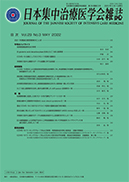Volume 29, Issue 3
Displaying 1-22 of 22 articles from this issue
- |<
- <
- 1
- >
- >|
-
2022Volume 29Issue 3 Pages 193
Published: May 01, 2022
Released on J-STAGE: May 01, 2022
Download PDF (484K)
-
2022Volume 29Issue 3 Pages 195
Published: May 01, 2022
Released on J-STAGE: May 01, 2022
Download PDF (867K) -
2022Volume 29Issue 3 Pages 196
Published: May 01, 2022
Released on J-STAGE: May 01, 2022
Download PDF (899K) -
2022Volume 29Issue 3 Pages 197
Published: May 01, 2022
Released on J-STAGE: May 01, 2022
Download PDF (914K) -
2022Volume 29Issue 3 Pages 198
Published: May 01, 2022
Released on J-STAGE: May 01, 2022
Download PDF (839K) -
2022Volume 29Issue 3 Pages 199
Published: May 01, 2022
Released on J-STAGE: May 01, 2022
Download PDF (845K)
HIGHLIGHTS IN THIS ISSUE
-
2022Volume 29Issue 3 Pages 201-203
Published: May 01, 2022
Released on J-STAGE: May 01, 2022
Download PDF (610K) -
2022Volume 29Issue 3 Pages 204-205
Published: May 01, 2022
Released on J-STAGE: May 01, 2022
Download PDF (595K) -
2022Volume 29Issue 3 Pages 206-208
Published: May 01, 2022
Released on J-STAGE: May 01, 2022
Download PDF (238K) -
2022Volume 29Issue 3 Pages 209-210
Published: May 01, 2022
Released on J-STAGE: May 01, 2022
Download PDF (606K)
CASE REPORTS
-
Article type: case-report
2022Volume 29Issue 3 Pages 211-215
Published: May 01, 2022
Released on J-STAGE: May 01, 2022
Download PDF (778K) -
Article type: case-report
2022Volume 29Issue 3 Pages 216-218
Published: May 01, 2022
Released on J-STAGE: May 01, 2022
Download PDF (2236K) -
Article type: case-report
2022Volume 29Issue 3 Pages 219-223
Published: May 01, 2022
Released on J-STAGE: May 01, 2022
Download PDF (3148K) -
Article type: case-report
2022Volume 29Issue 3 Pages 224-228
Published: May 01, 2022
Released on J-STAGE: May 01, 2022
Download PDF (3183K)
BRIEF REPORTS
-
Article type: brief-report
2022Volume 29Issue 3 Pages 229-230
Published: May 01, 2022
Released on J-STAGE: May 01, 2022
Download PDF (627K) -
Article type: brief-report
2022Volume 29Issue 3 Pages 231-232
Published: May 01, 2022
Released on J-STAGE: May 01, 2022
Download PDF (303K) -
Article type: brief-report
2022Volume 29Issue 3 Pages 233-235
Published: May 01, 2022
Released on J-STAGE: May 01, 2022
Download PDF (580K) -
Article type: rapid-communication
2022Volume 29Issue 3 Pages 236-237
Published: May 01, 2022
Released on J-STAGE: May 01, 2022
Download PDF (1514K) -
Article type: brief-report
2022Volume 29Issue 3 Pages 238-239
Published: May 01, 2022
Released on J-STAGE: May 01, 2022
Download PDF (1768K) -
Article type: brief-report
2022Volume 29Issue 3 Pages 240-241
Published: May 01, 2022
Released on J-STAGE: May 01, 2022
Download PDF (671K)
COMMITTEE REPORTS
-
2022Volume 29Issue 3 Pages 243-246
Published: May 01, 2022
Released on J-STAGE: May 01, 2022
Download PDF (701K) -
2022Volume 29Issue 3 Pages 247-253
Published: May 01, 2022
Released on J-STAGE: May 01, 2022
Download PDF (1334K)
- |<
- <
- 1
- >
- >|
